Ribbon seal
| Ribbon seal[1] | |
|---|---|
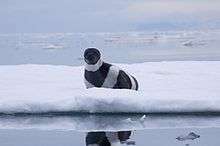 | |
| Scientific classification | |
| Kingdom: | Animalia |
| Phylum: | Chordata |
| Class: | Mammalia |
| Order: | Carnivora |
| Suborder: | Caniformia |
| Clade: | Pinnipedia |
| Family: | Phocidae |
| Genus: | Histriophoca Gill, 1873 |
| Species: | H. fasciata |
| Binomial name | |
| Histriophoca fasciata (Zimmermann, 1783) | |
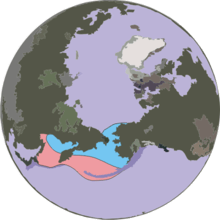 | |
| Ribbon seal range (blue – summer, pink – maximal) | |
The ribbon seal (Histriophoca fasciata) is a medium-sized pinniped from the true seal family (Phocidae). A seasonally ice-bound species, it is found in the Arctic and Subarctic regions of the North Pacific Ocean, notably in the Bering Sea and Sea of Okhotsk. It is distinguished by its striking coloration, with two wide white strips and two circles against dark brown or black fur.
It is the only living species in the genus Histriophoca,[1] although a possible fossil species, H. alekseevi, has been described from the Miocene of Moldova.[3]
Description
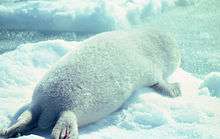
Adult seals are recognizable by their black skin, which carries four white markings: a strip around the neck, one around the tail and a circular marking on each body side,[4] which encloses the front fins. The contrast is particularly strong with the males, while with females the difference in color between bright and dark portions is often less conspicuous. Newborn ribbon seal pups have white natal fur. After moulting their natal fur, their color changes to blue-grey on their backs and silvery beneath; after some years some portions become darker and others brighter, and only at the age of four years does the typical pattern emerge.
The ribbon seal has a large inflatable air sac that is connected to the trachea and extends on the right side over the ribs. It is larger in males than in females, and it is thought that it is used to produce underwater vocalizations, perhaps for attracting a mate. The ribbon seal can grow about 1.6 m (5.2 ft) long, weighing 95 kg (209 lb) in both sexes.
Habitat
The ribbon seal lives in the Arctic parts of the Pacific Ocean. During winter and spring, it hauls out on pack ice to breed, molt, and give birth. During this time, it is found at the ice front in the Bering and Okhotsk Seas.[5] During the summer and autumn, the ribbon seal lives in open water, though some move north as the ice recedes with warmer temperatures. Little is known about its habit during this time, as it is so far from land and human observation. The ribbon seal almost never comes to land.
Thus far, there have been only three acknowledged instances where ribbon seals have been found as far south as Seattle, Long Beach, Washington and even further south at Morro Bay, California. There was nothing to suggest that illness was the cause of either seals appearance at either place, as they appeared to be healthy.[6][7]
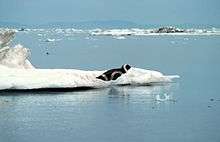
Behavior
The diet of ribbon seal consists almost exclusively of pelagic creatures: fish like pollocks, eelpouts, the Arctic Cod and cephalopods such as squid and octopus; young seals eat crustaceans as well. The ribbon seal dives to depths of up to 200 m in search of food; it is solitary and forms no herds. Females reach sexual maturity at 2 to 5 years and males reach sexual maturity at 3 to 6 years, and an individual may reach twenty to twenty-five years of age. Mating takes place from late April to early May.[5] Young animals are born on the ice in April and May. They are fed for four weeks on their mother's milk, then leave their mother. They remain on the ice for a few more weeks, in which they lose their dense white fur and lose a drastic amount of weight. After this period, they are able to dive and hunt by themselves.
Predators of the ribbon seal include the orca, the Pacific sleeper shark, the polar bear and the Arctic sleeper shark.
Protection
Young ribbon seals look like young harp seals, and like these, they were hunted for their fur. Since they do not form herds, ribbon seals were more difficult to catch than harp seals. Since the Soviet Union limited the hunt on ribbon seals in 1969, their population has recovered. The current population is around 250,000.
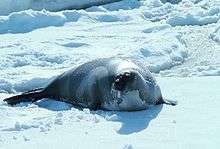
In March 2008 the US government agreed to study Alaska's ribbon seal population and considered adding it to the endangered species list. However, in December 2008, the US government decided that sea ice critical to the seals' survival will not be endangered by global warming, and declined to list the species.[8][9] Instead, it became a U.S. National Marine Fisheries Service Species of Concern. The US Government’s National Oceanic and Atmospheric Administration, National Marine Fisheries Service (NMFS), has some concerns regarding status and threats of some species, for which insufficient information is available to list them under the US Endangered Species Act.
In the summer of 2009 the Center for Biological Diversity filed suit to get the decision changed. On July 10, 2013, after again reviewing the status of this species, the National Marine Fisheries Service found that listing under the ESA was not warranted.[10]
References
- 1 2 Wozencraft, W.C. (2005). "Order Carnivora". In Wilson, D.E.; Reeder, D.M. Mammal Species of the World: A Taxonomic and Geographic Reference (3rd ed.). Johns Hopkins University Press. ISBN 978-0-8018-8221-0. OCLC 62265494.
- ↑ Lowry, L. (2016). Histriophoca fasciata. The IUCN Red List of Threatened Species doi:10.2305/IUCN.UK.2016-1.RLTS.T41670A45230946.en
- ↑ Berta, A. & Churchill, M. (2012). "Pinniped Taxonomy: evidence for species and subspecies". Mammal Review. 42 (3): 207–234. doi:10.1111/j.1365-2907.2011.00193.x.
- ↑ Saundry, Peter (2010). Ribbon seal. Encyclopedia of Earth. C.Michael Hogan (Topic Editor). Cutler J. Cleveland, ed. National Council for Science and the Environment, Washington DC
- 1 2 SCS: Ribbon Seal (Phoca fasciata). pinnipeds.org
- ↑ Rare sea creature appears on Seattle woman's dock. LiveScience via Yahoo News (January 21, 2012)
- ↑ "Rare Arctic ribbon seal observed near Surfside". Chinook Observer. August 18, 2016.
- ↑ Govt: Ribbon seals not endangered. Associated Press. 23 December 2008
- ↑ Boveng, P.L. et al. (2008). Status Review of the Ribbon Seal (Histriophoca fasciata). Seattle, WA: U.S. Dept. of Commerce, National Oceanic and Atmospheric Administration, National Marine Fisheries Service, Alaska Fisheries Science Center.
- ↑ NMFS (July 10, 2013). "Endangered and Threatened Wildlife; Determination on Whether To List the Ribbon Seal as a Threatened or Endangered Species" (PDF). Federal Register. 78: 41371–41384.
External links
| Wikimedia Commons has media related to Histriophoca fasciata. |
- Overview pages on ribbon seals (Histriophoca fasciata) hosted by:
- Range map on OBIS*SEAMAP
- Voices in the Sea – Sounds of the Ribbon Seal
